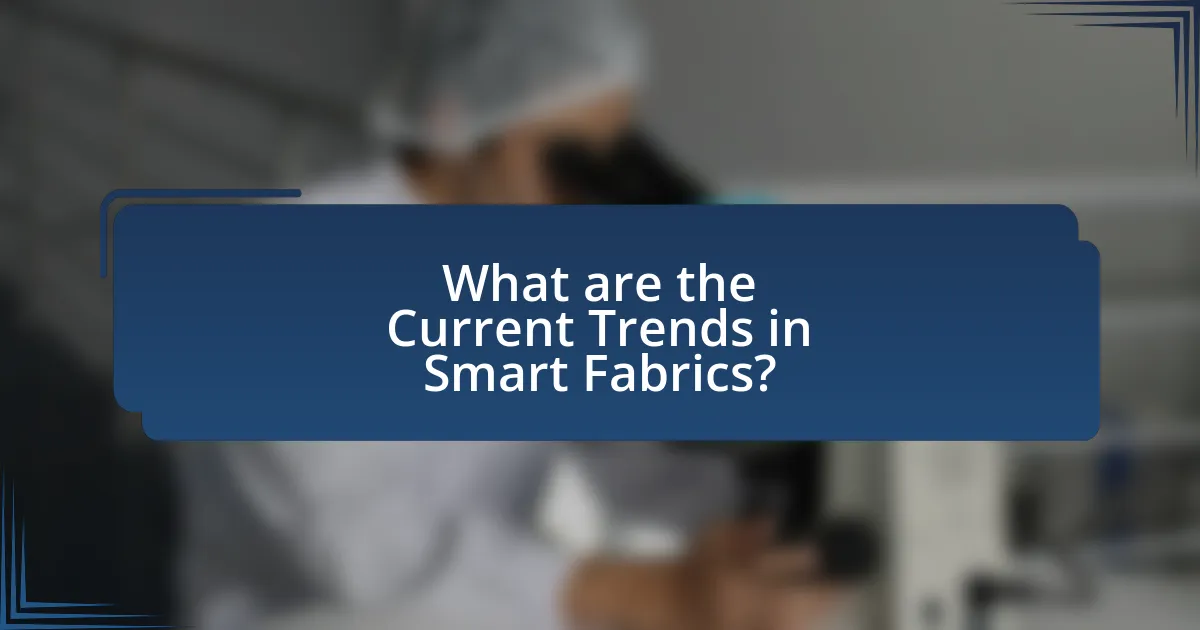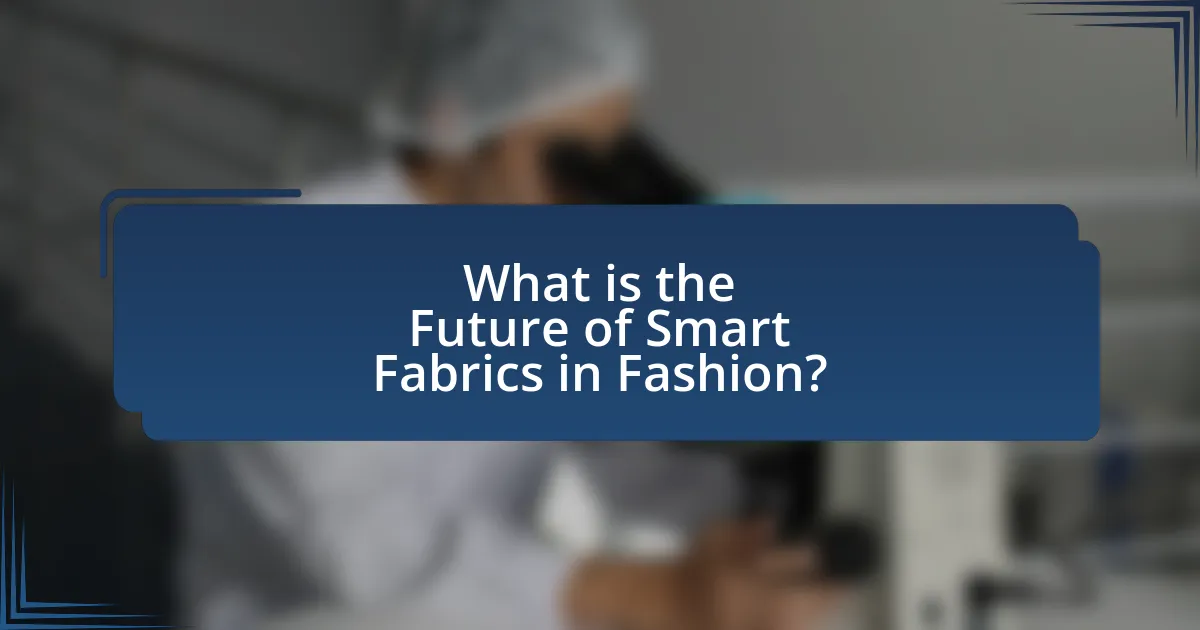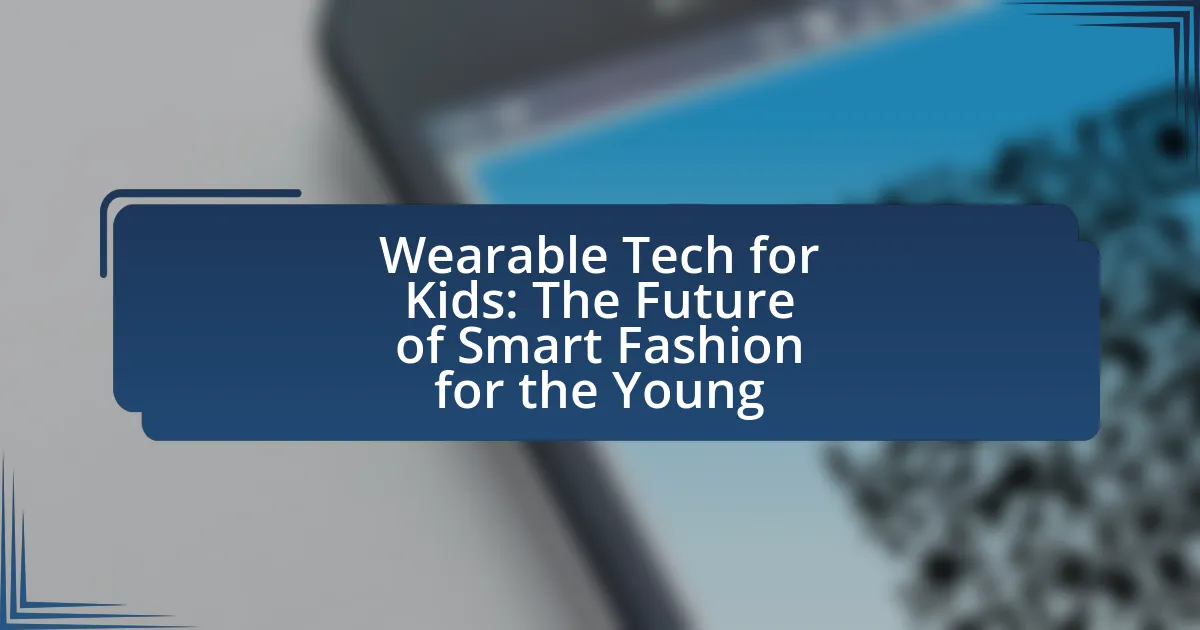Smart fabrics, integrated with wearable technology, are textiles that can sense and respond to environmental stimuli, enabling functionalities such as health monitoring and temperature regulation. This article explores the evolution of smart fabrics, detailing their integration with wearable devices, the materials used, and the historical developments that have shaped their current applications. It highlights current trends, notable examples in fashion, and the impact of consumer preferences on the industry. Additionally, the article addresses the challenges faced in the adoption of smart fabrics, including sustainability concerns and barriers to consumer acceptance, while also discussing future innovations and the role of artificial intelligence in enhancing their functionality.

What are Smart Fabrics and Wearable Technology?
Smart fabrics are textiles embedded with technology that enables them to sense and respond to environmental stimuli, while wearable technology refers to electronic devices worn on the body that often incorporate smart fabrics. These innovations allow for functionalities such as monitoring health metrics, adjusting temperature, and enhancing user interaction with digital devices. For instance, a study published in the journal “Advanced Materials” highlights how smart textiles can monitor physiological signals, demonstrating their potential in health and fitness applications.
How do smart fabrics integrate with wearable technology?
Smart fabrics integrate with wearable technology by embedding sensors and conductive materials that enable data collection and interaction with electronic devices. These fabrics can monitor physiological signals such as heart rate, temperature, and movement, allowing for real-time health tracking and feedback. For instance, a study published in the journal “Advanced Materials” highlights how smart textiles can communicate with smartphones to provide users with health insights, demonstrating the practical application of this integration in fitness and medical monitoring.
What materials are used in smart fabrics?
Smart fabrics are primarily made from materials such as conductive fibers, polymers, and textiles embedded with sensors. Conductive fibers, often made from metals like silver or copper, enable electrical conductivity, allowing the fabric to interact with electronic devices. Polymers, including elastomers and thermoplastics, provide flexibility and durability while integrating electronic components. Additionally, textiles can be enhanced with sensors that monitor various parameters like temperature, moisture, and movement, making them responsive to environmental changes. These materials collectively contribute to the functionality and versatility of smart fabrics in wearable technology.
How do sensors and electronics function within smart fabrics?
Sensors and electronics within smart fabrics function by integrating miniature devices that can collect data, process information, and communicate with other devices. These sensors, such as temperature, pressure, and motion sensors, are woven or embedded into the fabric, allowing the material to respond to environmental changes or user interactions. For instance, a temperature sensor can monitor body heat and adjust the fabric’s insulation properties accordingly. This integration enables functionalities like health monitoring, where data is transmitted to smartphones or other devices for analysis, enhancing user experience and providing real-time feedback. The effectiveness of these systems is supported by advancements in microelectronics and materials science, which have made it feasible to create lightweight, flexible, and durable sensors that maintain the fabric’s comfort and wearability.
What are the historical developments of smart fabrics?
Smart fabrics have evolved significantly since their inception in the late 20th century, beginning with the introduction of conductive fibers in the 1960s. In the 1980s, the development of electronic textiles emerged, integrating sensors and actuators into fabrics, which allowed for basic interaction with the environment. The 1990s saw advancements in microelectronics, enabling more sophisticated functionalities such as temperature regulation and moisture management in textiles. By the early 2000s, companies like DuPont and Philips began commercializing smart fabrics, leading to applications in sportswear and healthcare. The introduction of nanotechnology in the 2010s further enhanced the capabilities of smart fabrics, allowing for improved durability and performance. Today, smart fabrics are utilized in various sectors, including fashion, healthcare, and military applications, showcasing their versatility and potential for future innovations.
How have technological advancements influenced smart fabric evolution?
Technological advancements have significantly influenced the evolution of smart fabrics by enabling the integration of sensors, connectivity, and advanced materials. Innovations such as conductive fibers and flexible electronics have allowed for the development of fabrics that can monitor physiological signals, communicate with devices, and adapt to environmental conditions. For instance, the introduction of nanotechnology has led to the creation of fabrics that can repel water and stains while maintaining breathability, enhancing both functionality and comfort. Additionally, advancements in wireless communication technologies, like Bluetooth and NFC, have facilitated seamless data transfer between smart fabrics and smartphones, making them more user-friendly and accessible. These developments underscore the transformative impact of technology on the capabilities and applications of smart fabrics in the fashion industry.
What milestones have marked the journey of wearable technology in fashion?
The journey of wearable technology in fashion has been marked by several key milestones, including the introduction of the first smart textiles in the late 1990s, the launch of fitness trackers like Fitbit in 2009, and the unveiling of smartwatches such as the Apple Watch in 2015. These milestones demonstrate the evolution of wearable technology from basic functionality to sophisticated integration with fashion, as seen in collaborations between tech companies and fashion designers, such as the partnership between Google and Levi’s for the Jacquard jacket in 2017. Additionally, the rise of health-monitoring garments, like those developed by companies such as Hexoskin, showcases the increasing demand for functionality in fashionable attire.

What are the Current Trends in Smart Fabrics?
Current trends in smart fabrics include the integration of advanced sensors for health monitoring, the development of energy-harvesting textiles, and the use of sustainable materials. Health-monitoring fabrics, such as those embedded with biosensors, allow for real-time tracking of vital signs, enhancing personal health management. Energy-harvesting textiles, which convert kinetic energy into electrical energy, are being explored for powering wearable devices. Additionally, the shift towards sustainable materials reflects a growing consumer demand for eco-friendly fashion, with innovations in biodegradable and recycled fabrics gaining traction. These trends indicate a significant evolution in the functionality and sustainability of smart fabrics within the fashion industry.
How are designers incorporating smart fabrics into their collections?
Designers are incorporating smart fabrics into their collections by integrating textiles that can monitor health metrics, adjust temperature, and respond to environmental changes. For instance, brands like Ralph Lauren have developed shirts with built-in sensors that track heart rate and activity levels, showcasing the practical application of smart fabrics in everyday wear. Additionally, companies such as Adidas are utilizing moisture-wicking and temperature-regulating materials to enhance athletic performance, demonstrating how smart fabrics can improve functionality in sportswear. These innovations reflect a growing trend in the fashion industry where technology and textiles converge, allowing for garments that not only serve aesthetic purposes but also provide enhanced user experiences.
What are some notable examples of smart fabric applications in fashion?
Notable examples of smart fabric applications in fashion include the use of conductive textiles in athletic wear, such as the Athos smart shirt, which monitors muscle activity and heart rate. Another example is the use of temperature-regulating fabrics in jackets like the Ralph Lauren PoloTech, which adjusts to body temperature. Additionally, the integration of LED technology in garments, such as the “Wearable Solar” dress by Studio Roosegaarde, allows for energy generation from sunlight. These applications demonstrate how smart fabrics enhance functionality and user experience in the fashion industry.
How do consumer preferences shape the trends in smart fabrics?
Consumer preferences significantly shape trends in smart fabrics by driving demand for functionality, comfort, and sustainability. As consumers increasingly prioritize health monitoring and performance-enhancing features, manufacturers are innovating to integrate sensors and responsive materials into their products. For instance, a survey by McKinsey & Company found that 70% of consumers are interested in clothing that can track fitness metrics, indicating a clear market trend towards health-oriented smart textiles. Additionally, the growing awareness of environmental issues has led consumers to favor sustainable materials, prompting brands to develop eco-friendly smart fabrics. This shift in consumer values directly influences the design and production strategies of companies in the smart fabric industry.
What industries are adopting smart fabrics beyond fashion?
Smart fabrics are being adopted in various industries beyond fashion, including healthcare, sports and fitness, automotive, and military applications. In healthcare, smart fabrics are utilized for monitoring vital signs and enhancing patient comfort through temperature regulation. The sports and fitness industry employs these fabrics for performance tracking and injury prevention, with products like smart shirts that measure heart rate and muscle activity. In the automotive sector, smart fabrics are integrated into vehicle interiors for enhanced safety features and comfort, such as seat sensors that monitor driver alertness. The military uses smart fabrics for uniforms that provide soldiers with real-time data and environmental protection. These applications demonstrate the versatility and growing importance of smart fabrics across multiple sectors.
How are smart fabrics being utilized in sports and fitness?
Smart fabrics are utilized in sports and fitness primarily for performance monitoring and enhanced comfort. These fabrics integrate sensors that track biometric data such as heart rate, body temperature, and muscle activity, providing athletes with real-time feedback on their performance. For instance, companies like Under Armour and Adidas have developed smart clothing that can analyze an athlete’s movements and suggest improvements, thereby optimizing training regimens. Additionally, smart fabrics can regulate temperature and moisture, improving comfort during workouts. Research indicates that the global smart textiles market is projected to reach $5.5 billion by 2024, highlighting the growing adoption of these technologies in sports and fitness.
What role do smart fabrics play in healthcare and medical applications?
Smart fabrics play a crucial role in healthcare and medical applications by enabling real-time monitoring of patients’ vital signs and health conditions. These advanced textiles incorporate sensors that can track metrics such as heart rate, temperature, and respiratory rate, providing continuous data to healthcare providers. For instance, a study published in the journal “Sensors” demonstrated that smart textiles could accurately monitor physiological signals, enhancing patient care and facilitating early detection of health issues. This integration of technology into fabrics not only improves patient outcomes but also promotes personalized medicine by allowing for tailored health interventions based on real-time data.

What is the Future of Smart Fabrics in Fashion?
The future of smart fabrics in fashion is poised for significant growth, driven by advancements in technology and increasing consumer demand for functionality and personalization. Smart fabrics, which integrate sensors and electronics, will enable garments to monitor health metrics, adjust temperature, and enhance user experience through connectivity with devices. According to a report by Research and Markets, the global smart textiles market is expected to reach $5.3 billion by 2024, reflecting a compound annual growth rate of 27.4% from 2019. This growth is fueled by innovations in materials science and the rising trend of wearable technology, indicating that smart fabrics will play a crucial role in the evolution of fashion, merging style with enhanced performance and interactivity.
How will advancements in technology impact smart fabrics?
Advancements in technology will significantly enhance the functionality and versatility of smart fabrics. Innovations such as improved sensor technology, nanotechnology, and advanced materials science will enable smart fabrics to monitor health metrics, respond to environmental changes, and provide enhanced comfort. For instance, the integration of flexible sensors can allow fabrics to track biometric data like heart rate and temperature, which has been demonstrated in research by Wang et al. (2020) in the journal “Nature Electronics.” Furthermore, developments in conductive fibers will facilitate better connectivity with devices, making smart fabrics more interactive and user-friendly. These technological improvements will ultimately lead to broader applications in healthcare, sports, and everyday wear, transforming how consumers interact with clothing.
What innovations are on the horizon for smart fabric development?
Innovations on the horizon for smart fabric development include advancements in energy harvesting, enhanced sensor integration, and improved textile conductivity. Energy harvesting technologies, such as piezoelectric materials, can convert mechanical energy from movement into electrical energy, powering wearable devices without batteries. Enhanced sensor integration allows fabrics to monitor vital signs and environmental conditions more accurately, facilitating real-time health tracking. Improved textile conductivity enables better communication between devices, leading to more responsive and interactive clothing. These innovations are supported by ongoing research in materials science and engineering, demonstrating the potential for smart fabrics to transform the fashion industry and wearable technology.
How might artificial intelligence influence the functionality of smart fabrics?
Artificial intelligence can significantly enhance the functionality of smart fabrics by enabling real-time data processing and adaptive responses to environmental stimuli. For instance, AI algorithms can analyze data from embedded sensors in smart fabrics to monitor physiological parameters such as heart rate and temperature, allowing for personalized adjustments in comfort and performance. Research indicates that AI-driven smart textiles can optimize energy consumption and improve user experience by automatically regulating temperature or moisture levels based on the wearer’s activity and surrounding conditions. This integration of AI not only increases the utility of smart fabrics but also paves the way for innovative applications in health monitoring, sports performance, and fashion design.
What challenges do smart fabrics face in the fashion industry?
Smart fabrics face several challenges in the fashion industry, including high production costs, durability issues, and consumer acceptance. High production costs arise from the complex technology and materials required to create these fabrics, making them less accessible to mainstream consumers. Durability issues stem from the integration of electronic components, which can affect the fabric’s lifespan and performance over time. Additionally, consumer acceptance is a significant hurdle, as many individuals are hesitant to adopt new technologies in clothing due to concerns about comfort, maintenance, and privacy. These challenges hinder the widespread adoption of smart fabrics in the fashion market.
How can sustainability be addressed in the production of smart fabrics?
Sustainability in the production of smart fabrics can be addressed by utilizing eco-friendly materials and implementing energy-efficient manufacturing processes. For instance, manufacturers can opt for organic cotton, recycled polyester, or biodegradable fibers, which significantly reduce environmental impact compared to conventional materials. Additionally, adopting processes that minimize water usage and carbon emissions, such as digital printing and low-temperature dyeing, further enhances sustainability. Research indicates that the textile industry is responsible for about 10% of global carbon emissions, highlighting the need for these sustainable practices to mitigate environmental harm.
What are the potential barriers to consumer adoption of smart fabrics?
The potential barriers to consumer adoption of smart fabrics include high costs, lack of awareness, and concerns about durability and maintenance. High costs deter consumers from purchasing smart fabrics, as they often come with a premium price tag compared to traditional textiles. Lack of awareness about the benefits and functionalities of smart fabrics limits consumer interest and understanding, making them hesitant to invest. Additionally, concerns regarding the durability and maintenance of smart fabrics, including their ability to withstand washing and wear over time, further inhibit widespread adoption. These factors collectively contribute to a slow uptake of smart fabrics in the consumer market.
What practical tips should consumers consider when choosing smart fabrics?
Consumers should consider the fabric’s functionality, durability, and compatibility with their devices when choosing smart fabrics. Functionality is crucial as it determines the specific features, such as moisture-wicking or temperature regulation, that the fabric offers. Durability is important because smart fabrics often incorporate electronic components, which need to withstand regular wear and washing; for instance, fabrics that are machine washable and resistant to wear can enhance longevity. Compatibility with devices ensures that the smart fabric can effectively connect and communicate with smartphones or other wearable technology, which is essential for optimal performance.





